Times are changing in the professional services industry. GenAI appears to have a meteorite-like impact and many firms are still unable to fully grasp the change. Will junior positions be at stake? And can tech innovations remodel complete workflows? In the first article of this miniseries, Simon-Kucher experts present the results of our latest survey and highlight the real underlying issues with the “AI-pocalypse”: The impact on pricing and revenue models.
There’s a lot of fear-mongering whenever an innovative business tech is introduced: Millions of jobs might be at stake. Industry experts and studies have outbid each other when it comes to analyzing the share of work likely automated by GenAI as well as the pace at which this change will happen.
Unlike previous waves of automation, GenAI is not just targeting blue-collar workers, but might have a so far unseen impact on white-collar workers such as lawyers, consultants, marketers, and auditors. Jobs that require advanced intellectual abilities and were considered a safe haven suddenly seem to be at stake.
For some, this might trigger memories of previous innovative technology launches: Consider the introduction of the electronic spreadsheet in the 70s, when a wave of panic swept over most accounting departments.
Do we really need accountants anymore? That was the big question back then.
The result? 50 years later, the accountancy industry is booming. Many new specialized jobs have been created, relying on electronic spreadsheets for more complex tasks like business forecasts and analytics.
A Morgan Stanley survey even says that the number of jobs in the industry has grown by more than 15 percent in the US, exceeding the annual GDP growth rate around 3.2 percent by far.
But will GenAI be like the spreadsheet? Or will it have the all-changing impact on the job market that has caused both excitement and panic throughout 2023?
Listing to the wind of change: How service firms’ revenue models will be affected
With our latest qualitative expert survey, we set out to demystify most aspects of the “AI-pocalypse” in the modern professional services industry. The true and lasting impact of GenAI will likely arrive much slower than many people expect but equally might be much bigger than assumed. What companies are facing is not like a meteor wiping out the dinosaurs but reminds us more of the slow decline of the Roman empire. #
Isn’t this good news? There is time to react! GenAI has already taken the world by storm with all its forceful impact, but it needs months or even years until professional services firms (as well as competitors) will use it in its fullest capacity.
That does not diminish the final impact and there is no reason to relax. Rather, now is the time to start thinking ahead, especially considering firms’ predominant revenue models.
The traditional approach of charging for time and materials now seems outdated. Although simply billing for every six minutes of work has served law firms and consultancies so well over the last decades.
The problem: This model fundamentally dis-incentivises productivity gains, as by now incremental work can often be charged to clients. And with a new technology that increases efficiency, such as GenAI, there is a risk of revenue leakage if tasks that would have previously taken hours or days are now done within a few minutes.
The time to finally consider the change has arrived and, with the help of Simon-Kucher experts, your company can also be at the forefront of this process.
Staying ahead of the curve: What firms are up to so far
To understand the recent developments, we engaged in multiple conversations with senior leaders of professional services firms across the UK, US, France, Spain, and the DACH region. The results point in a similar direction for nearly all firms we have spoken to.
In this first wave of implementing GenAI solutions in early 2024, firms are primarily focusing on efficiency gains in their existing workflows, rather than developing new solutions and offerings. In our survey, participants estimated a total cost reduction potential of 15-20% in the medium-term.
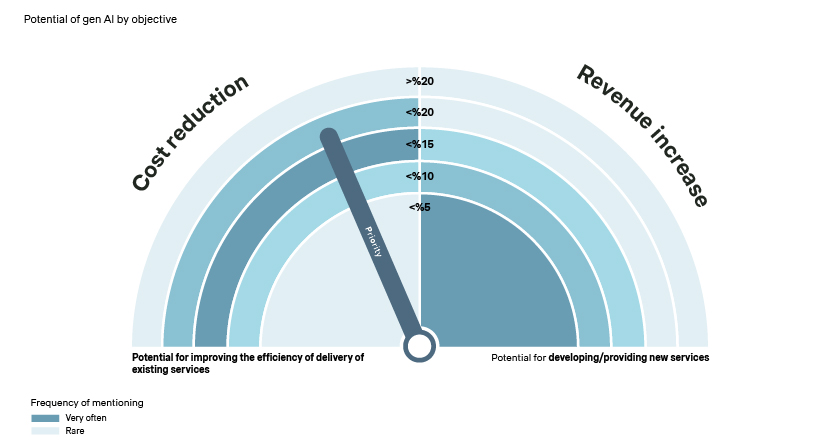
But while ambitious goals are set across most firms, the full spectrum of use cases remains unclear. Those companies introducing GenAI are mainly still testing it in a piloting phase. After the full hype in late 2022 and the first half of 2023, recent months have seen a disappointment in the impact of GenAI, with many companies now starting to downplay the impact of the technology on the professional services sector.
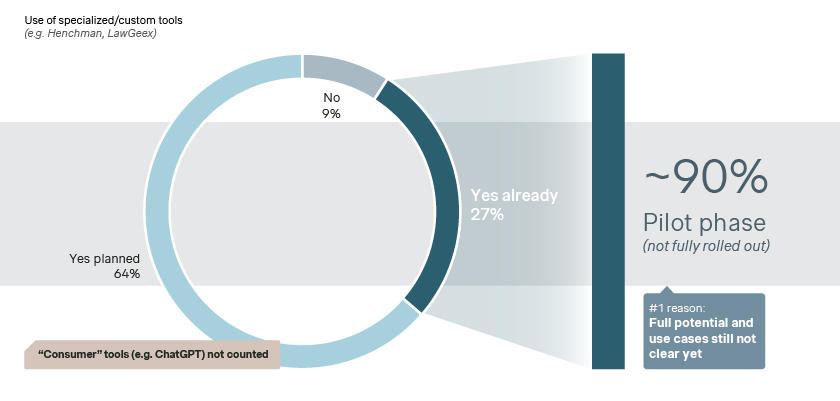
Yet, as with all technological change that follows an exponential path, gradual improvements cumulate to a significant impact in the long run.
Companies should watch out for the big changes that will impact them soon!
Our study results: Are juniors’ and young professionals’ jobs really at stake?
Compared to previous waves of automation-driven efficiency gains and rationalizations, the surveyed firms are certain that GenAI will affect all layers of the hierarchy, but especially with juniors and young professionals, the impact is exceedingly high.
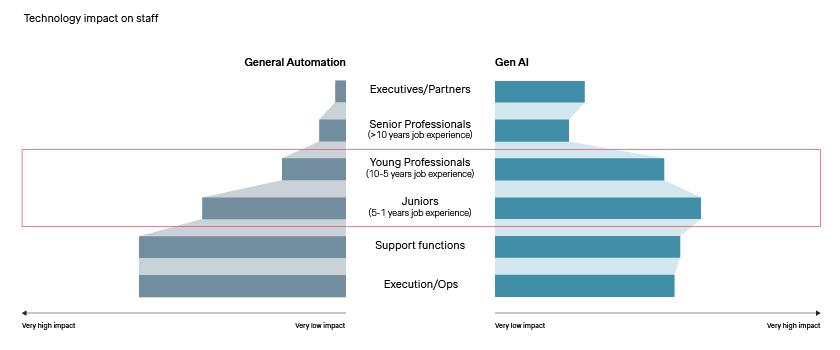
So, will the decade-old hierarchical pyramid collapse and simply become a block? How many jobs are really at stake in the long run?
While most survey participants expect the meteor to hit, which leads to high efficiency gains, nobody really thinks they are going to lay off the equivalent amount of people. Juniors might focus on more high-value tasks instead, potentially even climbing the ranks faster. While this might ultimately flatten the pyramid, it does not change its fundamental shape, which is ultimately a fundamental requirement to ensure a continuous development flow of new seniors for the future of every business.
Nonetheless, it remains a fact that the same task that took hours before can be now delivered in far less time. Consider diving through hundreds of pages of documents and summarizing them for the essential message regarding specifics in law or a business case. GenAI does this in minutes. Or writing a short prompt to analyze large datasets as opposed to painstakingly setting up a range of Excel formulas? GenAI can do that too. Drafting emails, documents, illustrations – you guessed it.
So as a business executive, ask yourself: Will you simply opt to transfer efficiency gains to your customers paying less for the hours of work, or will you act proactively to establish new rules in the market?
Questioning the decade old system: time-and-material pricing models
While the predominant pricing model stands out for its simplicity and compensation for all hours worked, it poses a tremendous risk of revenue leakage.
The sooner companies introduce GenAI tech, the more the task completion speed will increase. Time-and-material-based revenue models will struggle when tasks that used to take hours suddenly only take minutes.
But despite recognizing this need for change, our survey reveals a lack of clear readiness among firms to shift from the predominant monetization models to more sustainable options.
Most firms do not even expect to fundamentally change their current pricing models within the next couple of years. On average, time-and-material-based revenues will likely remain as high as 60 percent of total revenues, only a 20 percent decline from around 80 percent today (across the surveyed professional services firms), signaling a reliance on the status quo.
Clear plans on how to navigate future challenges are missing, which could include hybrid pricing models or introducing tech service maps with a future outlook on remodeling the complete pricing structure.
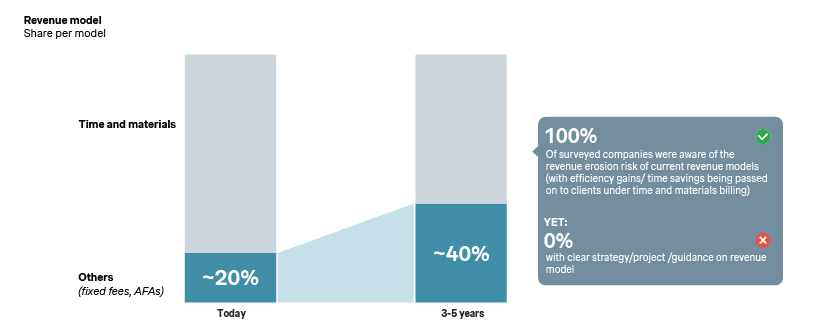
But even if most companies seriously considered the change, the main fear of our survey participants is the potential client pushback.
A chicken-and-egg scenario unfolds as the absence of firms pushing new monetization models into the market reduces clients’ acceptance for alternative arrangements trialed by individual companies, especially when their major competitors don’t dare to make a move.
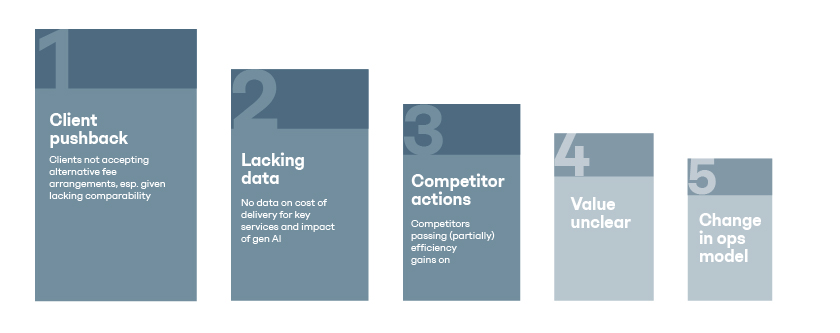
The second big challenge stems from the scarcity of the data sets, particularly in accessing information about the cost of delivering key services, which is often either unavailable or difficult to quantify. As such, firms struggle to find the right price point. The risk of not getting it right paralyses many in getting started on this transformational journey.
So, especially with the slightly reduced hype in recent months, we should not underestimate the long-term impact of GenAI – and unprepared professional services firms might otherwise end up like the Romans. Decline is slow, but it will hit everyone with time.
Struggling with the impact of GenAI? Our experts are here to help
The results of our survey point in a clear direction. The industry needs to update its revenue models. And at Simon-Kucher, we have years of experience in quantifying and packaging professional services and building value-based pricing models to avoid potential revenue leakages, especially those caused by new and innovative tech solutions. Our experts understand the challenges of GenAI but also know ways for our clients to grow with the tech together. And at Simon-Kucher Elevate we have a whole team dedicated to building up your GenAI strategies.
Contact our experts today to discuss the impact of generative AI also on your company!
And stay tuned for the next part of our two-part series, where we introduce several cutting-edge revenue and pricing models to redefine growth in the professional services industry. So, you can always stay ahead of the curve!








